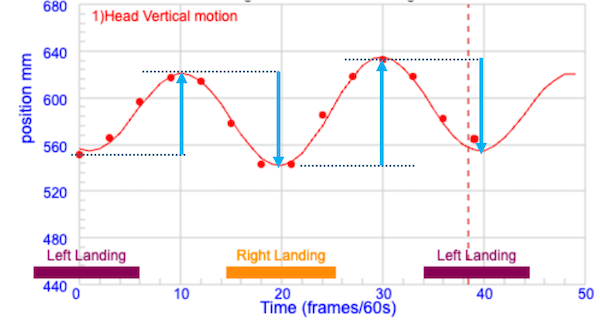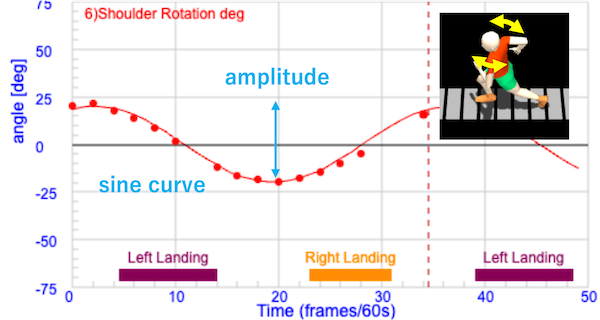Overview
Motion indicator is an index that we have named our own.
The way each joint moves is based on the regular motion of running, and the size, speed, phase, etc. differ slightly from runner to runner. These differences are the characteristics of each runner’s form.
Specifically, by expressing changes in the coordinates of joints and skeletal angles over time on a graph, it is possible to quantitatively grasp the form in motion. It takes some getting used to, but by looking at the graph and comparing with other runners, it is a useful indicator to discover more concrete differences. Please make use of it.
1 Head Vertical motion
Vertical movement of the head marker in mm.
This also represents the vertical movement of the body.
Vertical movement is a major indicator of form characteristics because it is strongly influenced by the absorption of landing impact, knee flexion and kicking foot during landing.

2 Speed km/h
This graph shows the change in horizontal position of the head marker between frames as velocity.
Heel landings are sometimes said to be a way of running that brakes, but the actual velocity change obtained often shows that many runners do not have a clear trend due to the wide variation in velocity.
The runner in this graph shows a characteristic change in speed. The speed drops significantly at the moment the right leg lands, and acceleration is clearly seen in the late phase of landing. On the other hand, the change is slightly different for the left leg landing.

3 Shoulder V mm
4 Shoulder -Head Vert. mm
This graph shows the change in the vertical difference between the position of the mark on the left shoulder and the position of the head.
When the body descends the most in the middle of the landing period, the shoulder also descends, and when the arm is pulled backward, the shoulder rises.
(However, depending on the position of the mark, a slightly excessive rise can easily be measured because the mark is positioned above it when the arms are swung widely.)

5 Shoulder-Head Hori. mm
6 Shoulder Rotation deg
The change in horizontal position difference between the left shoulder mark and the head mark was modeled as due to shoulder rotation.
The model representing the measurements as sine curves showed good agreement with respect to all runners.
The magnitude of shoulder rotation, including arm swing, for each runner is an indicator of some of the individual characteristics

7 Hip(L) vertical movement mm Hip(L) Vertical motion
8 Hip(left)-head Vertical movement mm Hip(L) to Head Vertical motion
9 Hip(L) back&forth movement mm Hip(L) back&forth movement
10 Hip(left) Y rotation angle Hip(L) Rotation
11 Knee(Left) Z-angle Knee(L) z-ang. 12 Knee(Right) Z-angle Knee(R) z-ang.
13 Thigh(Left) Z-Angle Upper Leg(L) z-ang.
14 Thigh(Right) Z-Angle Upper Leg(R) z-ang.
15 Lower Leg(Left) Z-Angle Upper Leg(R) z-ang.
15 Lower Leg(Left) Z-Angle Lower Leg(L) z-ang.
16 Lower Leg(Right) Z-Angle Lower Leg(R) z-ang.
17 Plantar(Left) Z-Angle Foot Sole(L) z-ang.
18 Plantar(Right) Z-Angle Foot(R) Sole z-ang.
19 Upper Arm(Left) Z-Angle Upper Arm(L) z-ang. 20 Upper Arm(Right) Z-Angle Upper Arm(R) z-ang.
21 Lower Arm(Left) Z-Angle Lower Arm(L) z-ang. 22 Lower Arm(Right) Z-Angle Lower Arm(R) z-ang.
23 Thigh(Left) Z-angle velocity Upper Leg(L) ang. velocity 24 Thigh(Right) Z-angle velocity Upper Leg(R) ang. velocity
25 Lower Leg(Left) Z-angle velocity Lower Leg(L) ang. velocity 26 Lower Leg(Right) Z-angle velocity Lower Leg(R) ang. velocity

